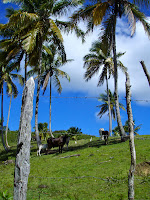Take a walk with me through Las Terrenas. We see quite a bit more than my camera can capture; men on motoconchos with televisions on their laps, families of four on a single vespa, maybe a dog in front with paws on the handle bars. There are dogs everywhere, large and small, and it seems they got the memo that any gringo – any foreigners at all – will share money and food if they beg long enough. Jokes on them, we tend not to have leftovers.
On our 30-minute walk from Casa Paz to the library we follow a single road, one of two main one-ways in Las Terrenas. We pass over the cool running creek on a crumbling bridge the width of my soldiers – to misstep would be a 10 foot fall into the same water locals use to bathe, clean laundry, and relieve themselves. We cross the street and follow the one-way past a few small “restaurants” serving on the patios of family homes with delicious local cuisine at low rates made cafeteria style and served at whatever large tables they could piece together: plastic, chipped wood, card tables, whatever. Then past a delicious French bakery and café with a well-shaded patio and low-priced espresso. Over a few potholes and we continue on past more family stores selling second-hand clothes with the likes of Abercrombie & Fitch, Old Navy, Gap, and numerous U.S. university T’s. Some are open windows with a sign in front and a case or two of empanadas or homemade deserts. Behind the window is a family kitchen, maybe a single room with a stove and a bed, maybe a dining table.
Beside the shops along the road the ‘sidewalk’ crumbles in places and curves this way and that at strange angles. There is no rule on the alignment of homes and buildings – I can’t imagine how any perfectionist could handle a stroll through town without a couple panic attacks. If there’s a single level in this town no one bothers to use it. I like to think of the chaos as creative construction.
Every day we see more kids; babies crawling on the pavement near the streets with stray dogs waltzing over them and toddlers climbing the loose wires and unkempt properties or unfinished building projects. Oh, and the downed power lines? We’re still waiting for a story to come out of those – they’re everywhere!
Between the shops and crawling naked babies are old women soaking their feet on the sidewalk, a baby in their lap and another one or two nearby. Not their children, of course, most likely grandchildren or great-grandchildren. Mixed amongst these sights
are a number of large lots piled top to bottom with beautiful Caribbean paintings. I can’t help but stare, though every time we pass we get haggled by one artist or another, desperate for a sale. I wish I could help them because their work is beautiful. Unfortunately, someone forgot to mention to these guys that posting three different “galleries” on a single street corner makes for fewer sales and higher competition. Oh well, the view is fabulous. We also pass along apartment buildings, bright hotels, grocery stores and beautiful patios filled with overgrown palms and tempting scents of freshly baked bread, smoked chicken, and well-seasoned rice and beans.
The most miraculous of our walks is a fact on Las Terrenas we recently learned. The old women we see? They definitely weren’t schooled. Their children weren’t either, unless they could afford to pay for a private bus to drive them at four in the morning over the mountains to the only school in the area. And all these little restaurants we pass? They’ve doubled and tripled in the past ten years after local effort was made to create small-loan programs (unfortunately the programs are based on minimal government funds and foreign donations, so while they are helpful, the money is inconsistent). Just ten years ago not a single road was paved and there was not one local school beyond 3rd grade. Education is basically brand-spanking new, as are the crumbling sidewalks (interesting). And those downed power lines we see? Just 16 years ago the government built the first power line in Las Terrenas. Before that, there had never been electricity in this town. Even after it was offered, the idea of purchasing something they’d never needed before seemed ridiculous and was very slowly accepted.
So for all my pompous comments on how many ways Las Terrenas is behind the U.S. they’re evolving quickly and I can’t blame them for having difficulty keeping up. While the slanted houses and crumbling sidewalks drive me crazy some days, the brightly colored clothes and beautiful paintings, the palm trees and the laughing naked babies make it worth the walk.
 |
| A Street View |
 |
| Local Apparel Shop |
 |
| The Corner Store |
 |
| A Painter's Studio |
 As my final post nearly a month after our return home from the Dominican Republic, it is difficult to explain exactly how thankful I am for the trip - in retrospect. The past month has been filled with a series of emotions and adjustments to US life.
As my final post nearly a month after our return home from the Dominican Republic, it is difficult to explain exactly how thankful I am for the trip - in retrospect. The past month has been filled with a series of emotions and adjustments to US life.











